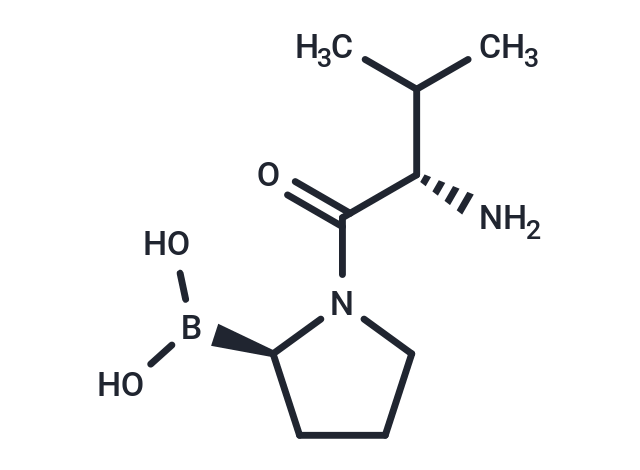Shopping Cart
- Remove All
 Your shopping cart is currently empty
Your shopping cart is currently empty

Talabostat (PT100, Val-boroPro) is a potent, nonselective and orally available dipeptidyl peptidase IV (DPP-IV) inhibitor with a Ki of 0.18 nM.

| Pack Size | Price | Availability | Quantity |
|---|---|---|---|
| 5 mg | $107 | Inquiry | |
| 10 mg | $159 | Inquiry | |
| 50 mg | $606 | Inquiry |
| Description | Talabostat (PT100, Val-boroPro) is a potent, nonselective and orally available dipeptidyl peptidase IV (DPP-IV) inhibitor with a Ki of 0.18 nM. Talabostat is a nonselective DPP-IV inhibitor, inhibiting DPP8/9, FAP, DPP2 and some other DASH family enzymes essentially as potently as it inhibits DPP-IV[1]. Talabostat stimulates the immune system by triggering a proinflammatory form of cell death in monocytes and macrophages known as pyroptosis. The inhibition of two serine proteases, DPP8 and DPP9, activates the proprotein form of caspase-1 independent of the inflammasome adaptor ASC[2]. Talabostat competitively inhibits the dipeptidyl peptidase (DPP) activity of FAP and CD26/DPP-IV, and there is a high-affinity interaction with the catalytic site due to the formation of a complex between Ser630/624 and the boron of talabostat[3]. Talabostat can stimulate immune responses against tumors involving both the innate and adaptive branches of the immune system. In WEHI 164 fibrosarcoma and EL4 and A20/2J lymphoma models, PT-100 causes regression and rejection of tumors. The antitumor effect appears to involve tumor-specific CTL and protective immunological memory. Talabostat treatment of WEHI 164-inoculated mice increases mRNA expression of cytokines and chemokines known to promote T-cell priming and chemoattraction of T cells and innate effector cells[3]. Talabostat treated mice show significant less fibrosis and FAP expression is reduced. Upon PT100 treatment, significant differences in the MMP-12, MIP-1α, and MCP-3 mRNA expression levels in the lungs are also observed. Treatment with PT100 in this murine model of pulmonary fibrosis has an anti-fibro-proliferative effect and increases macrophage activation[4]. [1]. Connolly BA, et al. Dipeptide boronic acid inhibitors of dipeptidyl peptidase IV: determinants of potencyand in vivo efficacy and safety. J Med Chem. 2008 Oct 9;51(19):6005-13. [2]. Okondo MC, et al. DPP8 and DPP9 inhibition induces pro-caspase-1-dependent monocyte and macrophage pyroptosis. Nat Chem Biol. 2017 Jan;13(1):46-53. [3]. Adams S, et al. PT-100, a small molecule dipeptidyl peptidase inhibitor, has potent antitumor effects and augments antibody-mediated cytotoxicity via a novel immune mechanism. Cancer Res. 2004 Aug 1;64(15):5471-80. [4]. Egger C, et al. Effects of the fibroblast activation protein inhibitor, PT100, in a murine model of pulmonary fibrosis. Eur J Pharmacol. 2017 Aug 15;809:64-72. |
| Targets&IC50 | DPP4:< 4 nM (IC50), DPP4:0.18 nM (Ki), DPP8/9:1.5/0.76 nM (Ki), DPP8/9:4/11 nM (IC50), QPP:310 nM (IC50), FAP:560 nM (IC50) |
| In vitro | Talabostat is a nonselective DPP-IV inhibitor, inhibiting DPP8/9, FAP, DPP2 and some other DASH family enzymes essentially as potently as it inhibits DPP-IV[1]. Talabostat stimulates the immune system by triggering a proinflammatory form of cell death in monocytes and macrophages known as pyroptosis. The inhibition of two serine proteases, DPP8 and DPP9, activates the proprotein form of caspase-1 independent of the inflammasome adaptor ASC[2]. Talabostat competitively inhibits the dipeptidyl peptidase (DPP) activity of FAP and CD26/DPP-IV, and there is a high-affinity interaction with the catalytic site due to the formation of a complex between Ser630/624 and the boron of talabostat[3]. |
| In vivo | Talabostat can stimulate immune responses against tumors involving both the innate and adaptive branches of the immune system. In WEHI 164 fibrosarcoma and EL4 and A20/2J lymphoma models, PT-100 causes regression and rejection of tumors. The antitumor effect appears to involve tumor-specific CTL and protective immunological memory. Talabostat treatment of WEHI 164-inoculated mice increases mRNA expression of cytokines and chemokines known to promote T-cell priming and chemoattraction of T cells and innate effector cells[3]. Talabostat treated mice show significant less fibrosis and FAP expression is reduced. Upon PT100 treatment, significant differences in the MMP-12, MIP-1α, and MCP-3 mRNA expression levels in the lungs are also observed. Treatment with PT100 in this murine model of pulmonary fibrosis has an anti-fibro-proliferative effect and increases macrophage activation[4]. |
| Molecular Weight | 214.07 |
| Formula | C9H19BN2O3 |
| Cas No. | 149682-77-9 |
| Storage | Powder: -20°C for 3 years | In solvent: -80°C for 1 year | Shipping with blue ice. | |||||||||||||||||||||||||||||||||||
| Solubility Information | DMSO: ≥ 40 mg/mL (186.85 mM), Sonication is recommended. | |||||||||||||||||||||||||||||||||||
Solution Preparation Table | ||||||||||||||||||||||||||||||||||||
DMSO
| ||||||||||||||||||||||||||||||||||||

Copyright © 2015-2025 TargetMol Chemicals Inc. All Rights Reserved.